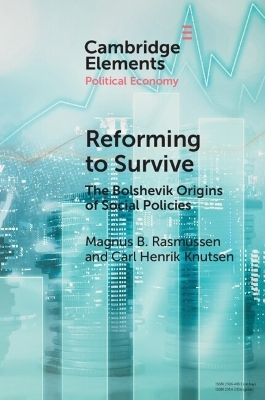
Reforming to Survive
The Bolshevik Origins of Social Policies
Seiten
2023
Cambridge University Press (Verlag)
978-1-108-99547-4 (ISBN)
Cambridge University Press (Verlag)
978-1-108-99547-4 (ISBN)
This Element details how elites provide policy concessions when they face credible threats of revolution. It assesses the argument by using original qualitative and quantitative data.
This Element details how elites provide policy concessions when they face credible threats of revolution. Specifically, the authors discuss how the Bolshevik Revolution of 1917 and the subsequent formation of Comintern enhanced elites' perceptions of revolutionary threat by affecting the capacity and motivation of labor movements as well as the elites' interpretation of information signals. These developments incentivized elites to provide policy concessions to urban workers, notably reduced working hours and expanded social transfer programs. The authors assess their argument by using original qualitative and quantitative data. First, they document changes in perceptions of revolutionary threat and strategic policy concessions in early inter-war Norway by using archival and other sources. Second, they code, for example, representatives at the 1919 Comintern meeting to proxy for credibility of domestic revolutionary threat in cross-national analysis. States facing greater threats expanded various social policies to a larger extent than other countries, and some of these differences persisted for decades.
This Element details how elites provide policy concessions when they face credible threats of revolution. Specifically, the authors discuss how the Bolshevik Revolution of 1917 and the subsequent formation of Comintern enhanced elites' perceptions of revolutionary threat by affecting the capacity and motivation of labor movements as well as the elites' interpretation of information signals. These developments incentivized elites to provide policy concessions to urban workers, notably reduced working hours and expanded social transfer programs. The authors assess their argument by using original qualitative and quantitative data. First, they document changes in perceptions of revolutionary threat and strategic policy concessions in early inter-war Norway by using archival and other sources. Second, they code, for example, representatives at the 1919 Comintern meeting to proxy for credibility of domestic revolutionary threat in cross-national analysis. States facing greater threats expanded various social policies to a larger extent than other countries, and some of these differences persisted for decades.
1. Introduction; 2. Literature review; 3. A theory of elite's policy responses to revolutionary threats; 4. Case study: revolutionary fear and elite responses in Norway, 1915–1924; 5. Measuring social policies and revolutionary threat across countries (2000 words); 6. Statistical analysis; 7. Mechanism of persistence: comintern, the formation of communist parties and the long-term effects of the Bolshevik revolution; 8. Conclusion; References.
| Erscheinungsdatum | 19.12.2022 |
|---|---|
| Reihe/Serie | Elements in Political Economy |
| Zusatzinfo | Worked examples or Exercises |
| Verlagsort | Cambridge |
| Sprache | englisch |
| Maße | 152 x 229 mm |
| Gewicht | 149 g |
| Themenwelt | Geschichte ► Allgemeine Geschichte ► Neuzeit (bis 1918) |
| Geisteswissenschaften ► Geschichte ► Regional- / Ländergeschichte | |
| Sozialwissenschaften ► Politik / Verwaltung ► Politische Systeme | |
| Sozialwissenschaften ► Politik / Verwaltung ► Politische Theorie | |
| Wirtschaft ► Volkswirtschaftslehre ► Wirtschaftspolitik | |
| ISBN-10 | 1-108-99547-0 / 1108995470 |
| ISBN-13 | 978-1-108-99547-4 / 9781108995474 |
| Zustand | Neuware |
| Informationen gemäß Produktsicherheitsverordnung (GPSR) | |
| Haben Sie eine Frage zum Produkt? |
Mehr entdecken
aus dem Bereich
aus dem Bereich
Giordano Bruno - ein ketzerisches Leben
Buch | Hardcover (2024)
C.H.Beck (Verlag)
29,90 €


